
Since autumn 2014 I am intensively looking for a way to get more reach without paying a lot of money and without needing a packhorse. I wrote a first article on that topic in December and a second one in February. Now, the second update would have been necessary. To avoid confusion I decided to join the two articles together. Here it goes:
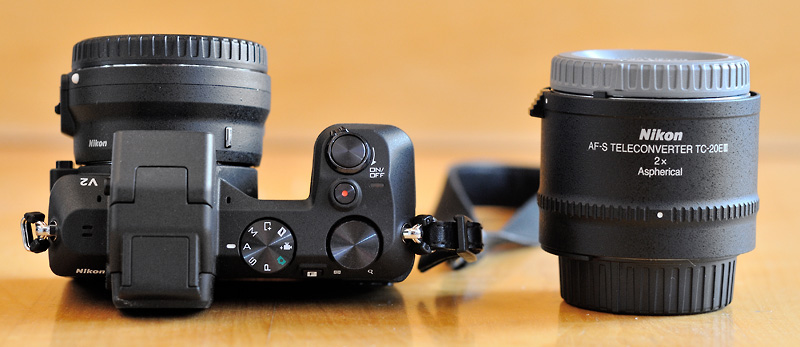
|
|
What is the better way for getting more reach: a higher pixel density or an optical enlargement? |
In terms of optical performance the AF-S 300mm f/4 is probably the best lens I currently own. I use it in conjunction with my FX cameras (D700 and D4) and often combined with my TC-14EII. It is an old lens, released in 1999. Nikon just introduced the successor, the 300mm f/4E PF VR. In terms of optical performance both lenses seem to be comparable. But the new one is lighter and offers VR. But for now, I decided to continue using the old one.
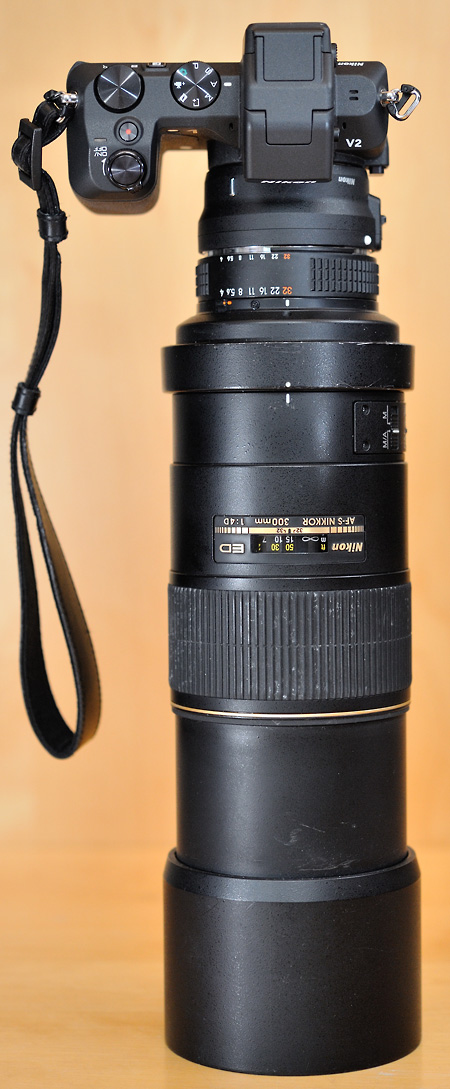
|
|
810mm equivalent: Nikon 1 V2 plus FT-1 adapter plus AF-S Nikkor 300mm f/4.
|
Sometimes I wish to have more reach. Well, I could sell my car and buy an AF-S 800mm f/5.6 instead ;) Even if I had the money that is not what I am looking for. I would like to have a relatively lightweight option.
My first try - two years ago - were the old TC-301 and TC-201 MF teleconverters between the D700 and the 300mm lens. The results were acceptable, but manual focussing without reliable help from the AF system is a serious practical issue. Have a look at my article about teleconverters and my subjective lens evaluations. Today, with the D4, a TC-20EIII in conjunction with my 300mm makes an AF 600mm f/8. My experience with that combo is described further below.
An alternative for getting more reach is to use a "digital zoom". For example, using a D300 instead of a D3 or using a D800 instead of a D4 is a digital 1.5x-zoom at the same pixel count. But there exists an option with a much higher zoom factor: the Nikon 1 system with the F-Mount adapter FT1. The Nikon 1 sensors are much smaller than a DX sensor: 13.2x8.8mm. Nikon calls this CX format. The crop factor from FX to CX is 2.7, thus the FX-equivalent of my 300mm lens on a CX sensor is 810mm. That is definitively more reach! The Nikon 1 V2 camera discussed here has 14MP which is comparable to the D4's 16MP. On the other hand, an FX sensor with the pixel density of the V2 would have 14MPx2.72 = 102MP!
So far the theory. But what about the combination of my good old 300mm lens and the high pixel density of the CX sensor in practice? To cut a long story short: In terms of the potential image quality it is a great combination! The resolution of the lens seems to be really high and the image quality of the small sensor is surprisingly good. Before I discuss the practical issues of this combination in comparison to the teleconverter solution I will start with a short review of the Nikon 1 system itself.
For trying the System 1 I needed a camera with a viewfinder. Without, it is not really possible to shoot hand-held or from a monopod with a longer lens! The V2 (including 10-30mm lens) is currently sold out for about 500 euros (black version), while the new V3 costs more than twice as much if you include the necessary finder. That made the decision easy for me - I bought a V2.
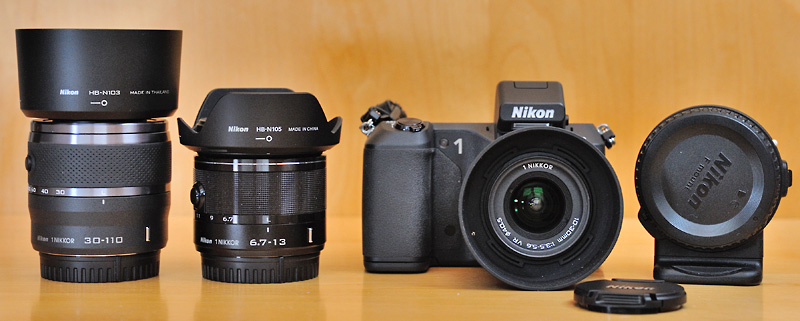
|
|
I am currently trying these parts of the System 1: the 1 V2 with the 10-30mm f/3.5-5.6 VR kit lens. On the left the 30-110mm f/3.8-5.6 VR telephoto zoom and the 6.7-13mm f/3.5-5.6 VR super wide-angle zoom. The FT1 adapter on the right allows the usage of F-Mount lenses. |
First of all and not surprising: This system is really small and lightweight. With a Nikon 1 camera you are inconspicuous. In a crowd of P&S shooters you won't attract attention. The equipment shown above covers FX equivalent focal lengths from 18mm to 300mm. Everything together (without the FT-1) weighs only about 800g! Due to the low weight and the fact that it can be remote-controlled by the cheap ML-L3, this is the camera to mount on a monopod for holding it over cliffs in order to get unusual views. Or upwards for having a close look into a bird's nest... A pity Nikon Camera Control Pro is not supported. Maybe an alternative: using your smartphone via the WU-1B WiFi adapter.
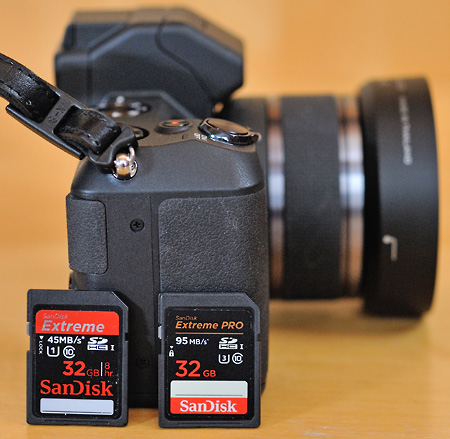
|
|
The Nikon 1 V2 is a fast camera. But it is not neccessary to buy expensive memory cards. I didn't measure a speed difference between SanDisk's Extreme and Extreme PRO cards when used in the V2.
|
Compared to an FX sensor the CX sensor is noisy. Again no surprise. But everything is relative: at ISO 400 the V2 produces much less noise than the Fujichrome Sensia ISO 100 slide film I used in earlier times. Seen absolutely: up to ISO 400 there is no problem with noise. ISO 800 is well usable. But I would try to avoid higher ISO values.
We DSLR shooters know: Nikon lets us pay for buffer capacity. The D4s ist super fast, the D810 is acceptable, the D7100 is terribly slow. Surprising: the buffer of the V2 can hold up to 40 RAW images. For continuous shooting you can select 5, 15, 30 or 60fps. The autofocus system is a hybrid of phase detection and contrast detection. It works up to 15fps. In terms of speed, this camera is a real bargain!
Very good are the display, the electronic viewfinder and the build quality. The ergonomics is also good, but please keep in mind the Nikon 1 cameras are more P&S than DSLR. Two things are a bit disappointing: the flash system is not compatible to anything and the camera needs unique batteries and a special charger.
On the web you will find comments like this: "The Nikon 1 32mm f/1.2 is a real bargain! It gives you an 85mm f/1.2 FX equivalent for less than half the price of the AF-S Nikkor 85mm f/1.4!" Of course, that is baloney! I have not tried it yet, but after all I've read the 32mm f/1.2 seems to be a great lens. A typical reason to buy it - like for the AF-S Nikkor 85mm f/1.4 - is the wish to isolate the subject from the background. But in terms of depth of field, the 32mm f/1.2 has an FX equivalent of a 85mm f/3.3. That is just the crop factor of 2.7, equivalent to nearly 3 f-stops! Thus, the 85mm f/1.4 FX lens isolates your subject much better.
If you set your CX and FX cameras to ISO 400 and mount the 32mm f/1.2 or the 85mm f/1.4 respectively, the Nikon 1 lens ist faster. Assuming you use both lenses wide open then if you need a 1/125sec on FX, you just need a 1/180sec on CX. That's true but it is not the whole truth! The FX camera is much less noisy, so just set it to ISO 1600 or 3200, and the FX combo will be much faster (1/500 or 1/1000sec)!
"Because of the small sensor you get much more depth of field!" That is another typical assumption you will find about small image sensors. Yes, it is true: with a CX camera at 13mm (=35mm in FX) and F5.6 you will get much more DOF than with a FX camera at 35mm and F5.6. But again, it is not the whole truth: stop down the FX camera to F16 and you have identical DOF on both cameras. But if you stop down the CX camera to F16 you will get a huge depth of field, unreachable for an FX camera. That is correct, but the results will appear a bit fuzzy all over because of diffraction! The theoretical diffraction limit of the V2 is at about F5.3. Therefore you should not stop down further than F5.6 or F8 usually.
Another problem is the size of the autofocus sensor. The smaller the image sensor the larger is the autofocus sensor in relation to the image. In many situations that makes focussing less precise. Capture NX2 allows to display the focus sensor, the screenshots below show the difference.
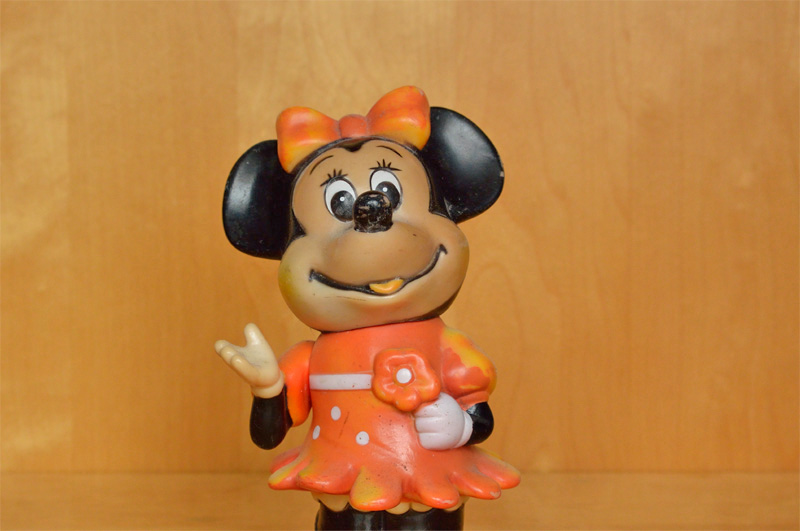
|
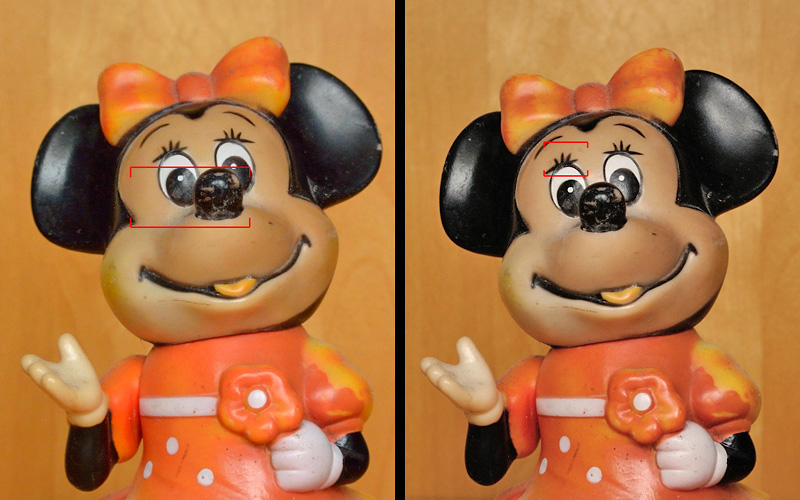
|
|
I made two identical shots of Minnie Mouse, one with the V2 at 22mm and one with the D700 at 60mm. The two crops show the size of the AF sensors. Left the CX camera, right the FX one. |
The most important advantage in my eyes is the size: the smaller sensor leads to much smaller and more lightweight equipment. I have already mentioned that above.
Secondly the small sensor is usable for microphotography. For example: the AF-S Micro-Nikkor 60mm f/2.8 hat a maximum magnification of 1:1. On a FX camera a magnification of 1:1 means you can photograph a square of 36x24mm. The lens also performs very good on the V2. But 1:1 here means you can photograph a square of 13.2x8.8mm! For photographing such small subjects with an FX camera you would need a magnification of 2.7:1, which in turn means you have to buy special equipment. Please have a look at my updated article Microphotography for a small budget.
My three zoom lenses are sharp and contrasty lenses. But you have to be careful when shooting into the sun! The build quality is fine. Every current Nikkor 1 lens has a bayonet mount made of metal.
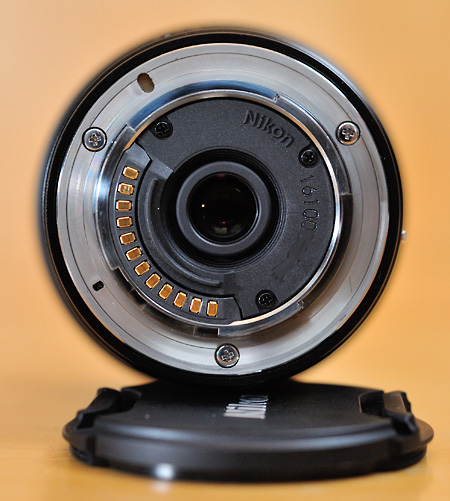
|
|
The lens' mount has no mechanical coupling elements and the diaphragm is completely closed.
|
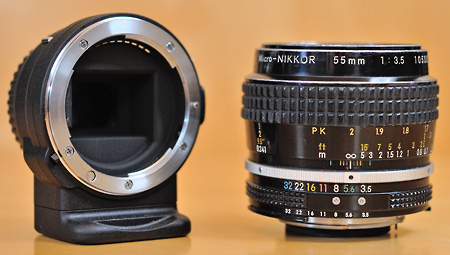
|
|
My good old Micro-Nikkor 55mm f/3.5 is not mountable!
|
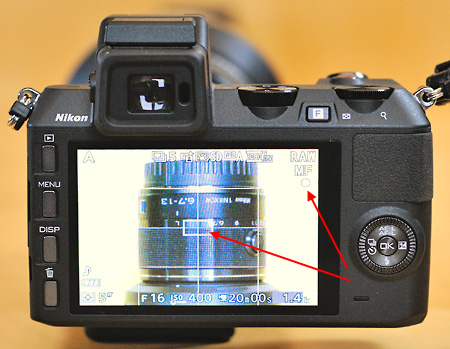
|
|
With a CPU lens on the FT1 you have a focus indicator on the fixed central focus sensor.
|
Nikon also offers a counterpart of their 18-200mm DX or 28-300mm FX superzooms respectively: the 10-100mm f/4-5.6 VR.
The most expensive lens of the system ist the super-telephoto zoom 70-300mm f/4.5-5.6 VR. It currently costs around 900 euros in Germany. This lens has a very good reputation.
In contrast to the zooms Nikon has only a poor lineup of primes in their System 1: a 10mm f/2.8 wide-angle lens, a 18.5mm f/1.8 standard lens and the above-mentioned short telephoto lens 32mm f/1.2. The 18.5 and 32mm lenses have a very good reputation, while the 10mm seems to be not much better than the kit-lens at 10mm. On the other hand the 10mm is a small pancake lens. The primes don't offer VR. I miss two lenses here: a fast (f/1.2) wide-angle and a Micro-Nikkor.
BTW: perhaps some Nikkor 1 lenses - especially the 10mm and 18.5mm primes - could be suitable - in reversed position - for microphotography applications. But there is a practical problem, the aperture of a One lens is completely closed if the lens is dismounted. A tube with some electronics in it would be necessary here, but I guess Nikon is not planning to produce something like that.
Thanks to the FT1 adapter you can use a lot of old Nikkor glass, even non-AI lenses. But be careful! Not every lens is mountable. Inside the adapter there is not enough space for some lenses!
If a non-CPU lens is mounted the camera does not show a focus indicator. Thus you must focus visually on the screen or in the EVF. If necessary, you can zoom in.
Non-CPU lenses allow A and M exposure mode. Matrix metering is not available.
With a CPU lens all exposure options are usable. You must focus manually, but now the camera additionally offers you a focus indicator coupled to the central focus sensor.
If the AF-S lens is set to M it behaves like a CPU lens described above. Up to this point everything sounds fine.
In AF-mode you have two unpleasant restrictions compared to native Nikon 1 lenses:
For months I thought - according to the V2's manual - AF-C would not be available with F-Mount Nikkors. By chance I found a hint on nikonusa.com that it is possible if both the camera and the FT1 have firmware version 1.1 or higher. My V2 had initially version 1.0 and the FT1 had 1.2. I updated the camera to 1.2 and it works! Unfortunately Nikon Europe offers the current 1.2 firmware for download, but they only list the (for me not that interesting) improvements over 1.1. They do not mention the improvements of 1.1 over 1.0 (including AF-C), like Nikon USA does.
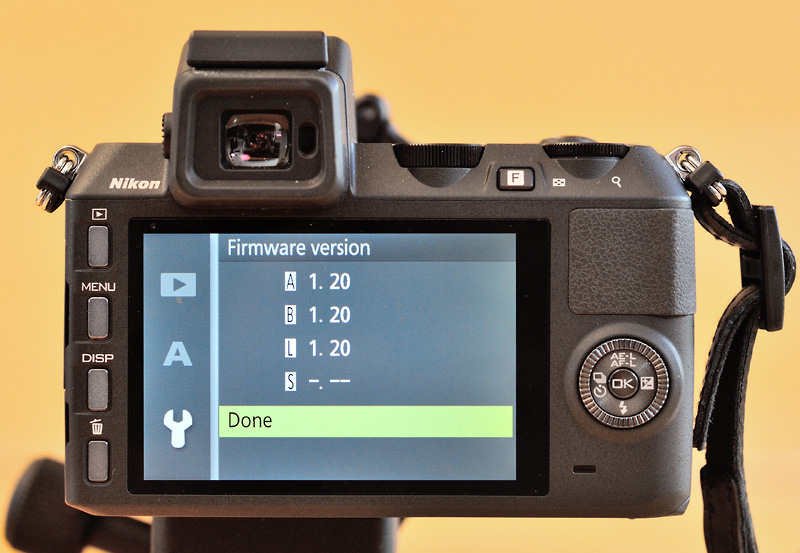
|
| The Nikon 1 system allows updates not only for cameras but also for lenses and flashes. "L" is the firmware version of the lens and "S" the one of the flash. Mounted here - instead of a lens - is my FT1 adapter. |
The performance of F-Mount Nikkors on the V2 is a mixed bag. The cheap AF-S 50mm f/1.8 delivers very good image quality. In contrast, my AF-S Micro-Nikkor 105mm f/2.8 doesn't produce consistent results, sometimes the quality is fine, sometimes the lens produces a more than usual amount of bokeh fringing. Moreover the AF of the V2 doesn't like the 105mm VR. For more details have a look at my subjective lens evaluations.
It is possible to use this combination with an equivalent focal length of 810mm and a weight of only 2kg hand-held. But it is difficult to hold your subject in the finder and much more difficult to hold it within the AF sensor. Resting the unit on anything is helpfull. Better is the usage of a monopod or a tripod. I guess a VR system would not really help here.
For me that means I have an extra weight of about 1.5kg in my bag: 500g for the 1 V2 including the FT1 and 1000g for a monopod including a ball head.
Once you have stabilised the unit you encounter the next problems: in some situations the large size of the AF sensor hinders proper focussing. If your subject is static, you can focus manually. Otherwise it is a game of luck. The fact that you are limited to the central AF sensor is a restriction for composing your image.
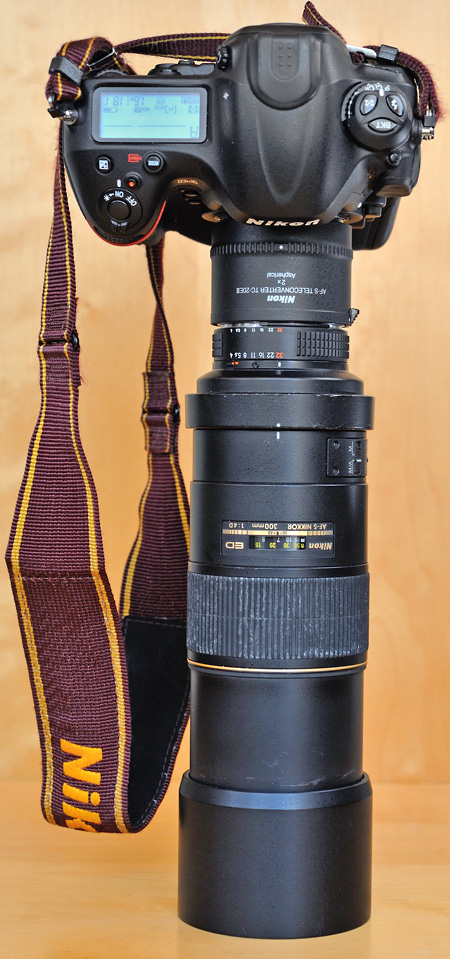
|
|
600mm: TC-20EIII plus AF-S Nikkor 300mm f/4. |
Overall, the AF system of the camera works acceptably in this combination. But you can not compare it to the reliability of an AF system of a better DSLR. Thus, you will have more failures.
The viewfinder image is slightly delayed. When shooting continuously (mostly I use the 5fps setting) the viewfinder image slows down and frequently "jumps" a bit.
The D4 has an improved AF system over the D3/D700, 11 of the 51 sensors still work at F8. Indeed, the autofocus of the D4 works fine with that combination. The restriction on 11 sensors is a drawback but overall the AF-System works clearly better than that of the 1 V2.
The optical viewfinder works always realtime and is therefore much better than the EVF of the 1 V2.
Due to the higher weight (D4 + TC-20EIII + 300mm = 3.2kg) this combo is overall better but not perfect for using hand-held. A monopod or tripod is strictly recommended here, too!
I compared the 1 V2 plus FT-1 with the D4 plus TC-20EIII at an FX equivalent of 810mm in terms of optical quality. I did it indoors with a distance of 5.5 metres between sensor and subject. For getting an equivalent of 810mm I had to take a 9MP crop from the D4 image. I downpixelled the 1 V2 image to the same size. Otherwise both images were just RAW converted with Capture NX2 without any additional processing. The 300mm lens was mounted on a tripod and the lens' weak tripod mount was stabilised (see my review of the AF-S 300mm f/4). I illuminated the subject with three daylight lamps. The images were captured with a shutter speed of 1/100sec. The 1 V2 was set to ISO 800 and F5.6, the D4 to ISO 3200 and F11. Of course, both cameras were released by wireless remote controls and the D4 was set to mirror-up mode.
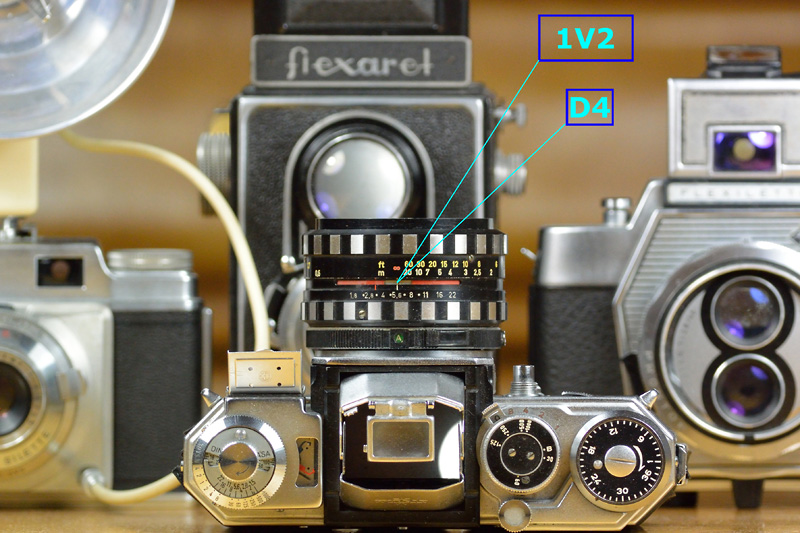
|
|
The image for the comparison. The focus was set to the centre of the frame (not otherwise possible with the 1 V2). Please note the different sizes of the AF sensors. Below there are four 100% crops of the above image - on the left D4 plus TC-20EIII, on the right 1 V2 plus FT-1. |
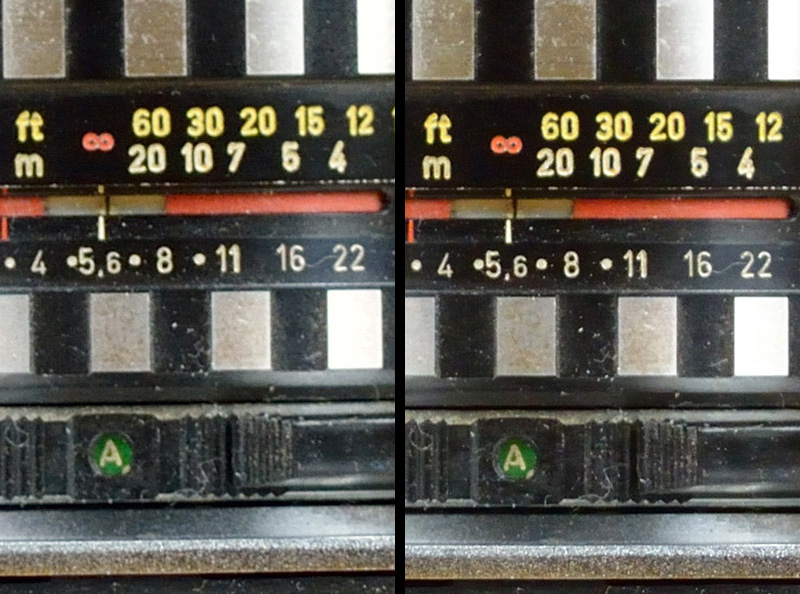
|
|
|
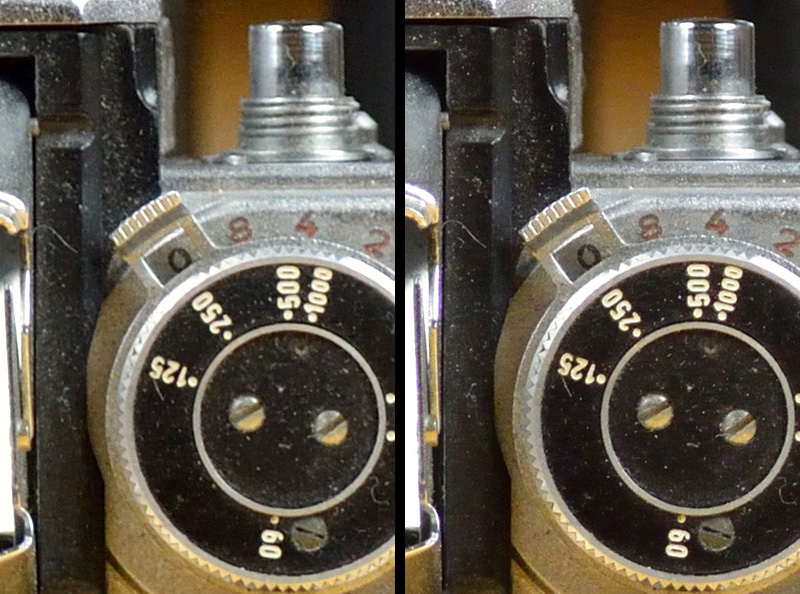
|
|
|
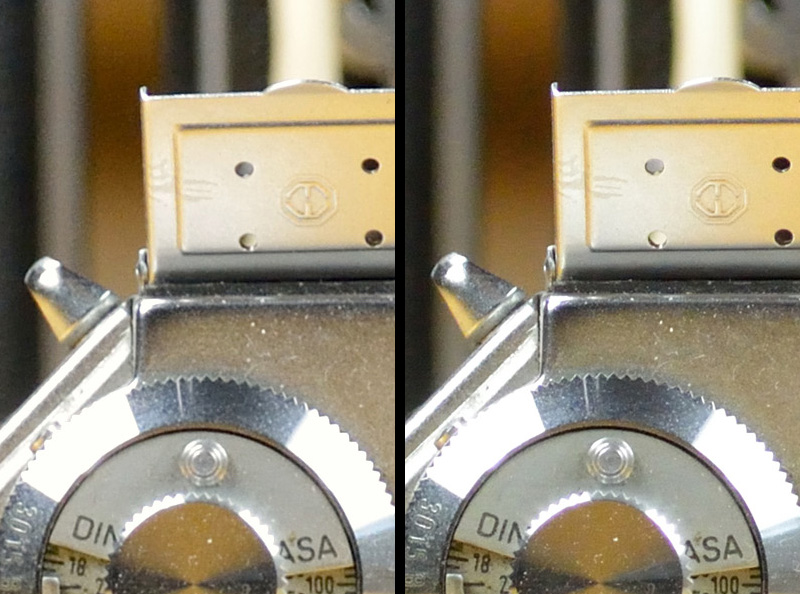
|
|
|
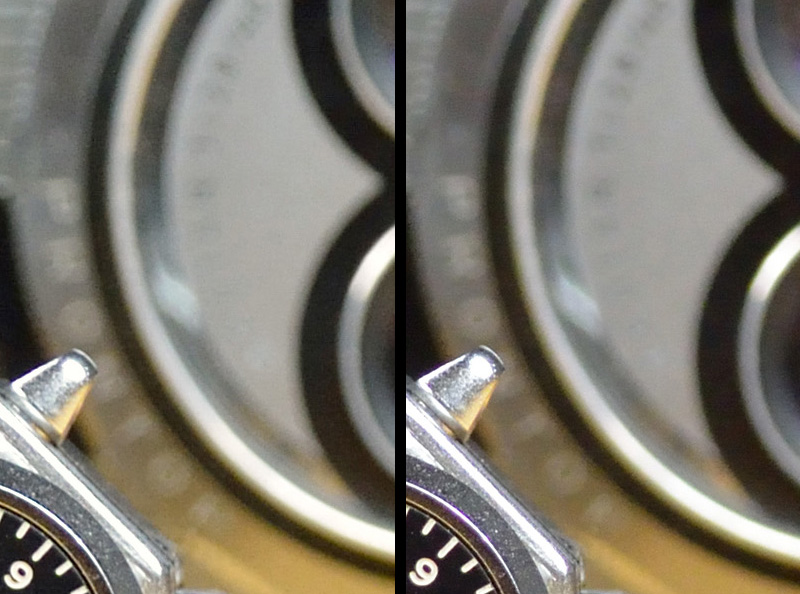
|
|
|
The 1 V2 shows a little bit more colour fringing but otherwise it clearly delivers the better image quality here! In terms of bokeh I do not see significant differences.
At first I thought there still would be problems with the tripod mount. Therefore I made another shot with the D4 without lamps but with flashes and 1/250sec. But the result was the same: the combination of TC-20EIII plus AF-S 300mm f/4 delivers slightly soft images.
I hoped to find both, very good image quality and usability in the field. But the result after two trials for getting more reach is not completely satisfying - I can only get either one or the other.
Nevertheless, after a few thousand shots in the field I can say both alternatives are overall usable.
Are there more alternatives?
Maybe, the just-announced AF-S 300mmm f/4E PF VR works better in conjunction with the TC-20EIII optically. But please take a look into the user's manual of the new lens. Nikon says on the TC-17E and TC-20E converters only AF-S mode would be available! Such a hint is not stated in the user's manuals of the newest cameras (D4S, D810, D750). Therefore I expect it is a lens-specific problem. Thus, getting more reach with the new 300mm PF means to pass on AF-C mode!
An alternative could be one of the Tamron or Sigma 150-600mm lenses. The best here seems to be the Sigma Sports lens which costs about 2000 euros and weighs 2.9kg. A pity Nikon do not produce a telephoto lens for non-professional wildlife photographers. In the 80s they had e.g. a 600mm f/4 and a 600mm f/5.6 in their lineup. BTW: still today, these old lenses have a very good reputation, but manual focussing is not exactly what I need in the 500-800mm range.
And what about a DX camera? I also made test shots with my family's D5100 plus TC-14EII plus AF-S 300mm f/4 at ISO 1600 and F8. But I found the performance to be slightly below the D4 plus TC-20EIII! Maybe, Nikon's newer 24MP DX imager without low-pass filter would deliver a bit more here. But I guess even the D7100 or D7200 will not level with the 1 V2 plus! Moreover, Nikon's current DX bodies do not get enough buffer to be the fast cameras a wildlife photographer needs. Because RAM costs nearly nothing today it is only stupid marketing. If you need a fast DX camera you must buy the D810 for 3000 euros!
At least there is an alternative for the Nikon 1: the 1 Nikkor 70-300mm f/4.5-5.6 VR zoom. The lens has a very good reputation and it is very lightweight. I expect the image quality to be a bit worse than the faster f/4 lens. The most important advantage: no AF restrictions. But it is not exactly cheap...
For now I have decided not to test further lenses in order to get more reach.
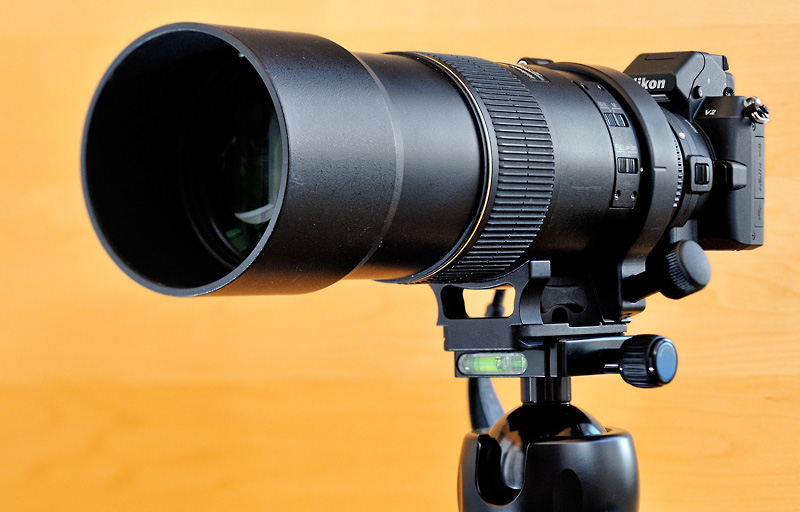
|
|
Stabilised: Nikon 1V2 plus FT-1 plus AF-S Nikkor 300mm f/4 with Kirk NC-300 tripod mount on Sirui K-40X. |
As a compromise I decided to prefer the 300mm f/4 plus CX body combination because of its better image quality and despite its practical issues. Usually I use a monopod for this combination, If necessary I will use a tripod instead. I invested some euros in a Kirk tripod mount for my 300mm lens and in a matching new ball head for my tripod. You can find my impressions about the Kirk mount in my updated AF-S 300mm f/4 review.
At the end of the summer I will be able to say if it was the right decision. I will let you know, stay tuned...
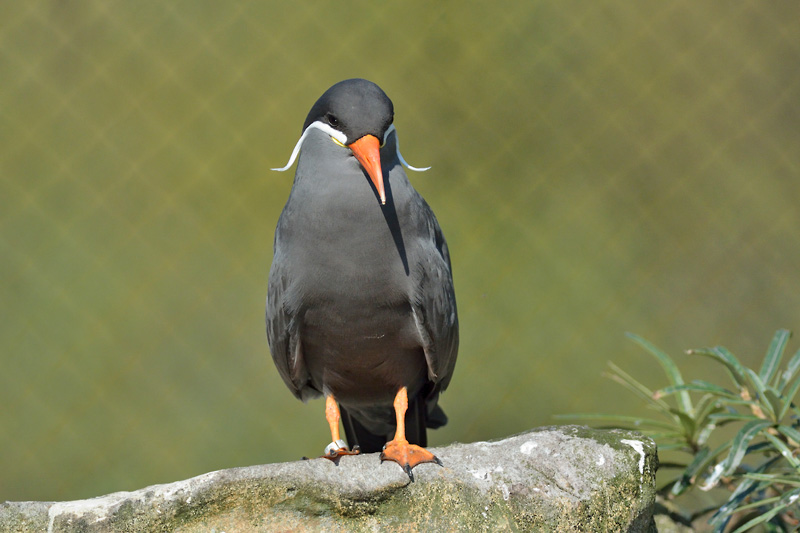
|
|
Visit to our local zoo: Inca tern. V2+FT1+AF-S 300mm at ISO 400, F5 and 1/1250, hand-held. |
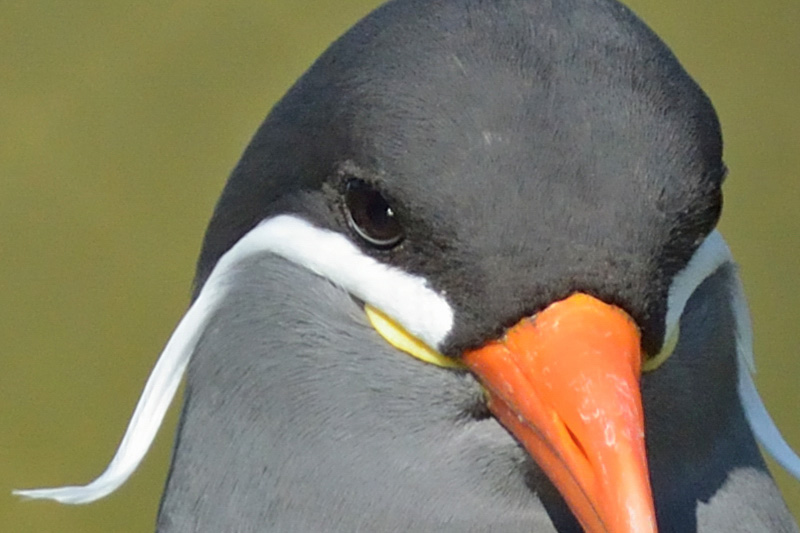
|
|
100%-crop of the above image. |

|
|
Visit to our local zoo: a distant relative of mine. V2+FT1+AF-S 300mm at ISO 800, F4 and 1/250, rested on the fence. |
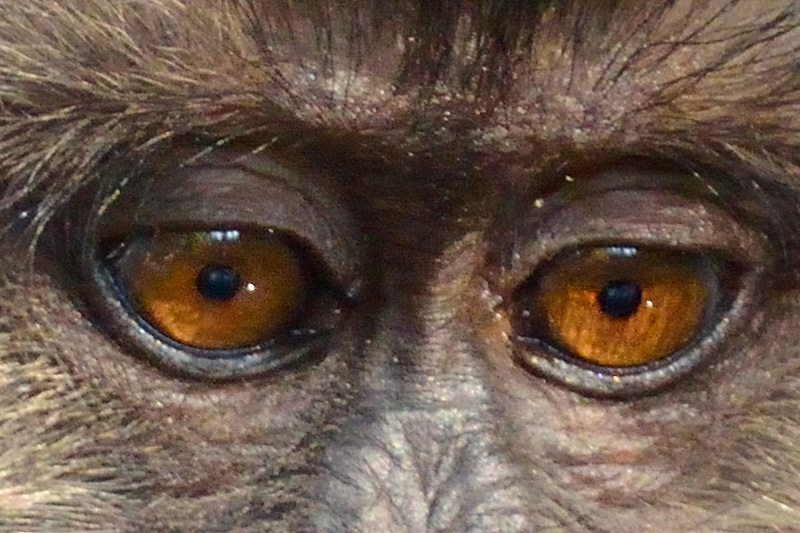
|
|
100%-crop of the above image. |
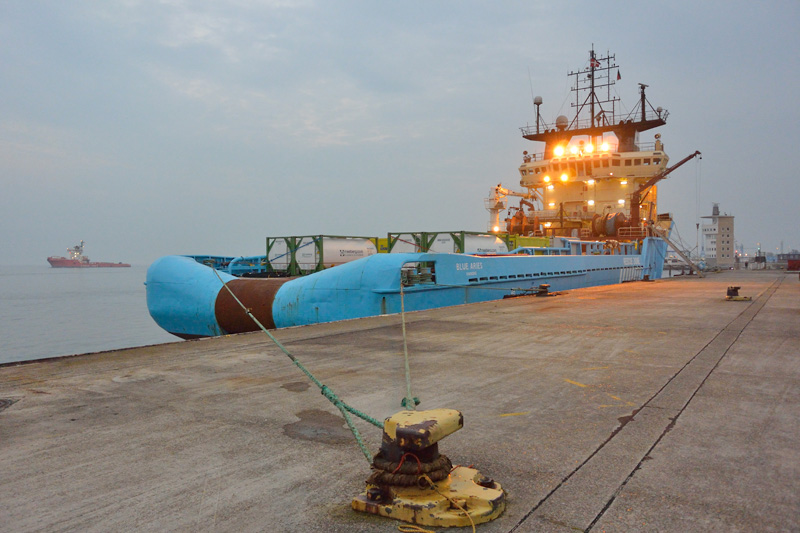
|
|
Evening in Cuxhaven, at the mouth of river Elbe. V2 + 10-30mm kit lens at 10mm, ISO 640, F3.5 and 1/60. |
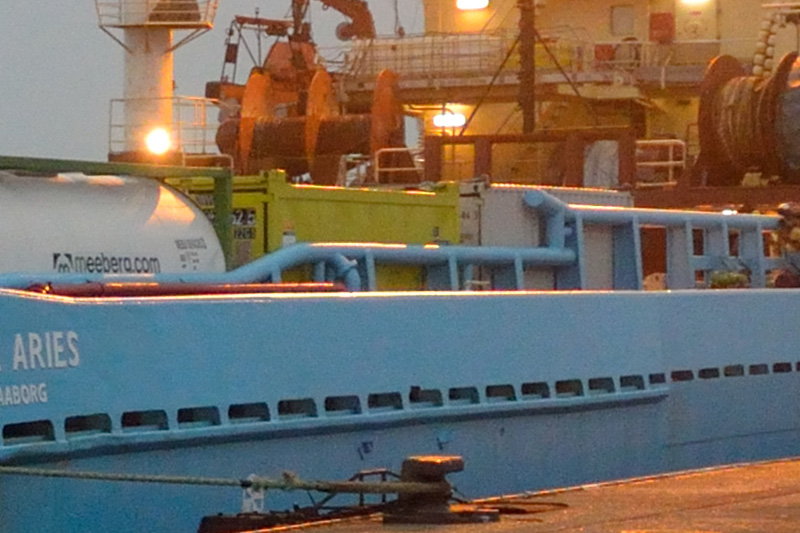
|
|
100%-crop of the above image. |
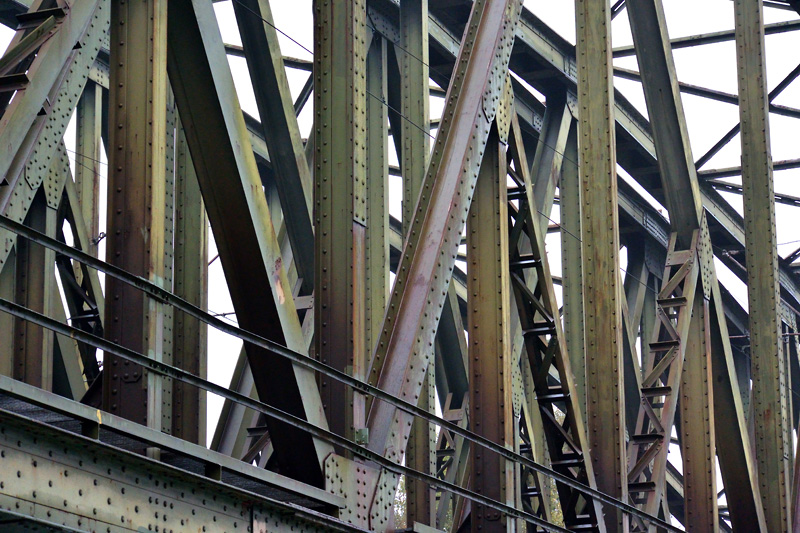
|
|
Railway bridge across the Dortmund-Ems Canal. V2 + 30-110mm at 41mm, ISO 800 and F4. |
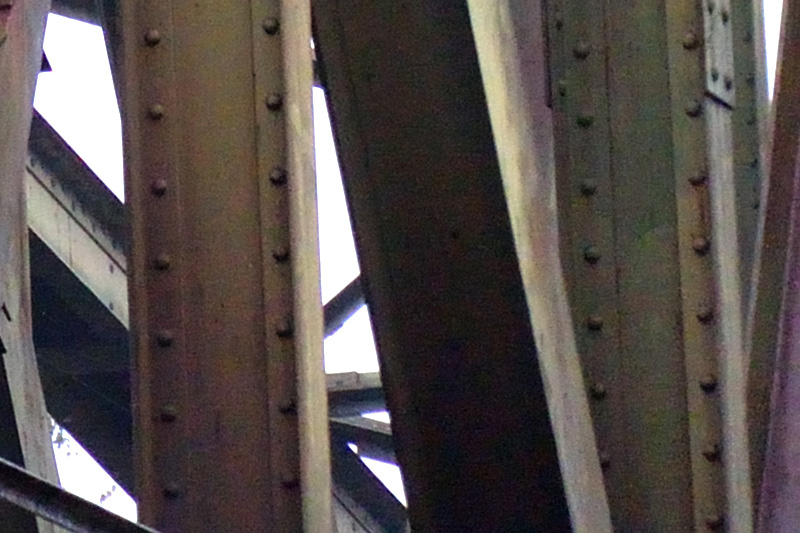
|
|
100%-crop of the lower right corner of the above image. |
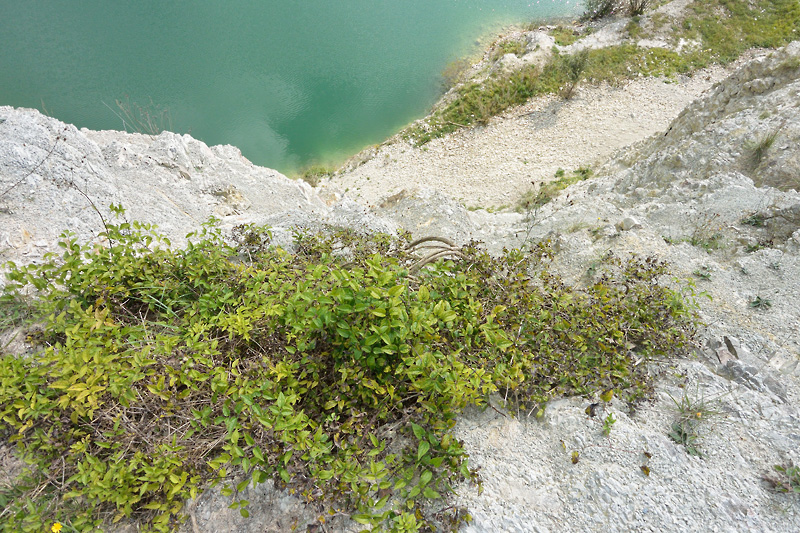
|
|
Above the edge - in a former limestone mine in Rheine. V2 + 6,7-13mm at 6,7mm, ISO 160 and F5, mounted on a momopod for holding over the edge. |
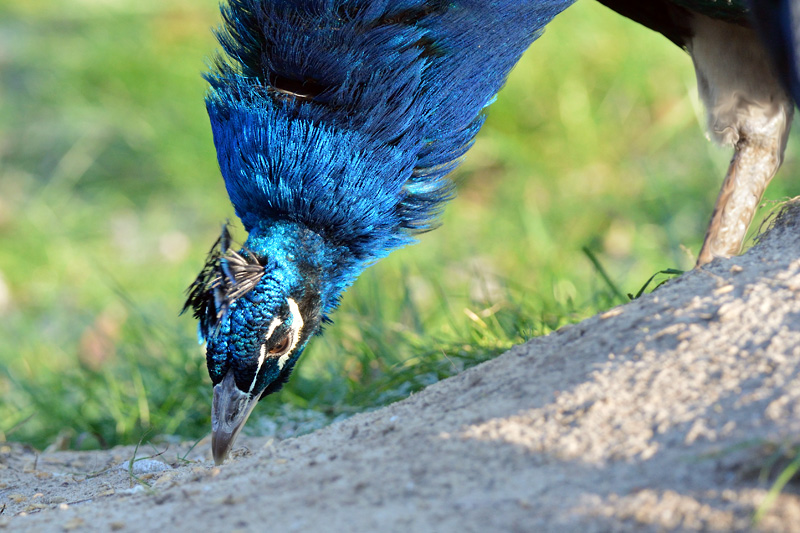
|
|
D4 + TC-20EIII + AF-S 300mm at ISO 2000, F11, 1/500sec, rested on the fence. The D4's AF system works fine! |
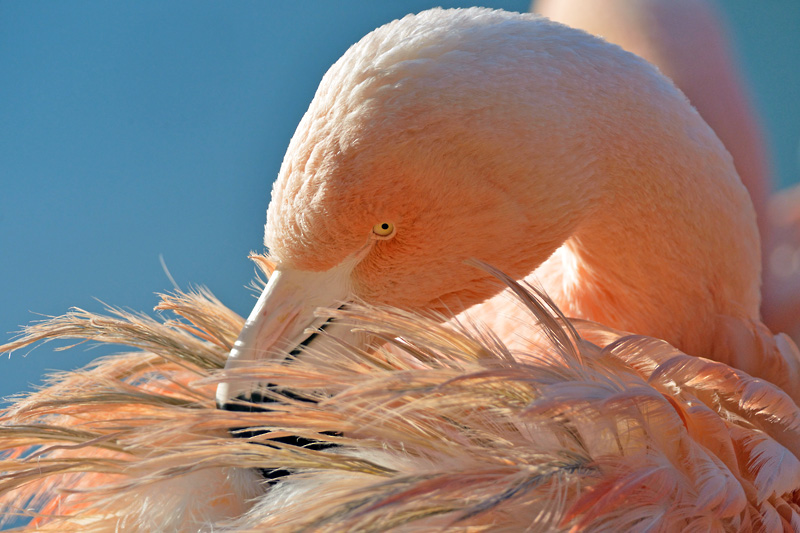
|
|
Wide open: D4 + TC-20EIII + AF-S 300mm at ISO 2000, F8 and 1/2500, hand-held. |
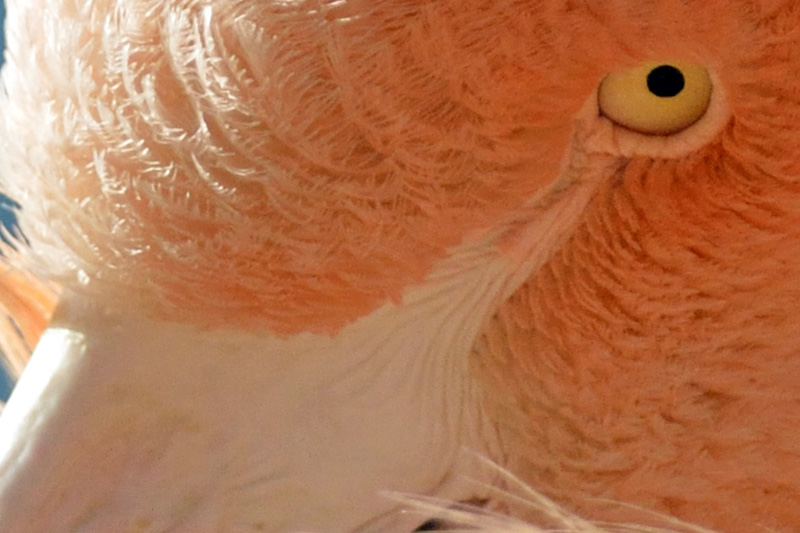
|
|
100% crop of the above image. |
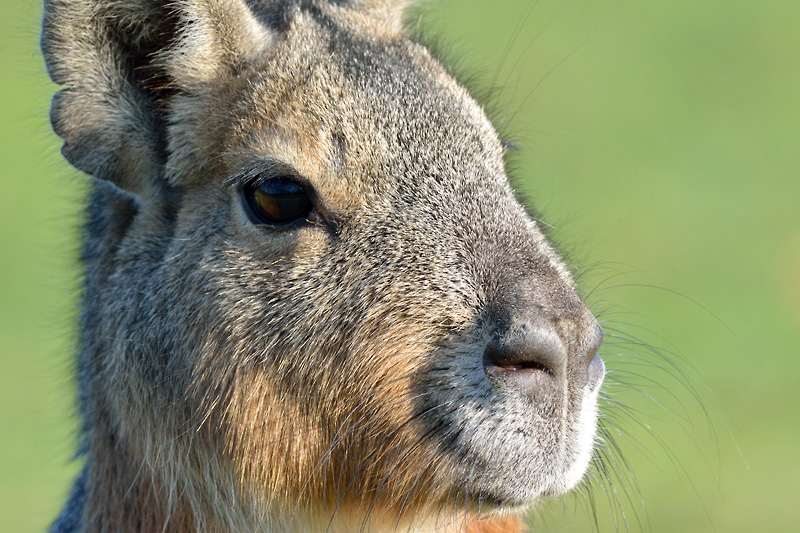
|
|
D4 + TC-20EIII + AF-S 300mm at ISO 2000, F11, 1/800sec, hand-held. |
After using the Nikon 1V2 plus FT-1 plus AF-S Nikkor 300mm f/4 for more than a year now, I have lost a bit of my initial enthusiasm for that combination.
First of all and no surprise: due to the relatively weak AF system of the 1V2 you produce more trash. Nevertheless, your sharp images deliver more reach. Overall, I found out that downpixelled to 75% and with some more than usual post-processing they are comparable to 100% images from the D4 plus TC-14EII plus AF-S 300mm f/4.
Please have a look at the eight images below - three of them are 100% D4 crops and five are 75% 1V2 crops. Please try to detect the camera used!
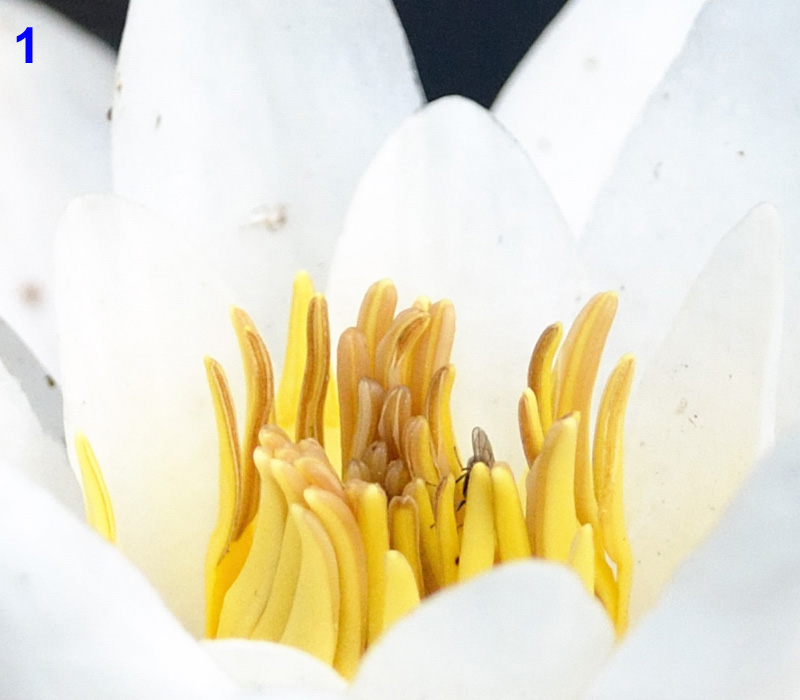
|
|
|

|
|
|
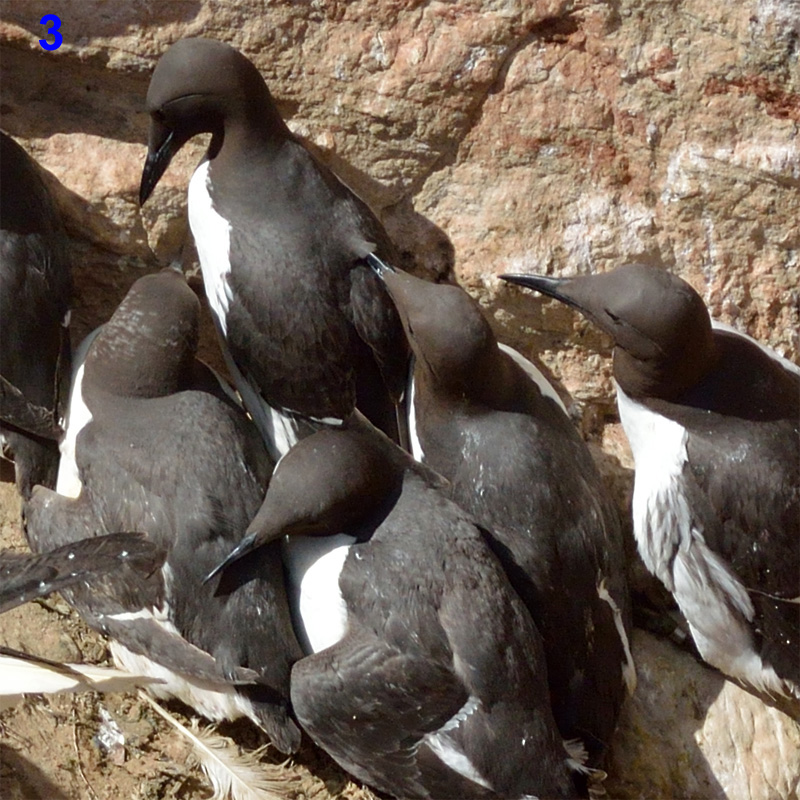
|
|
|
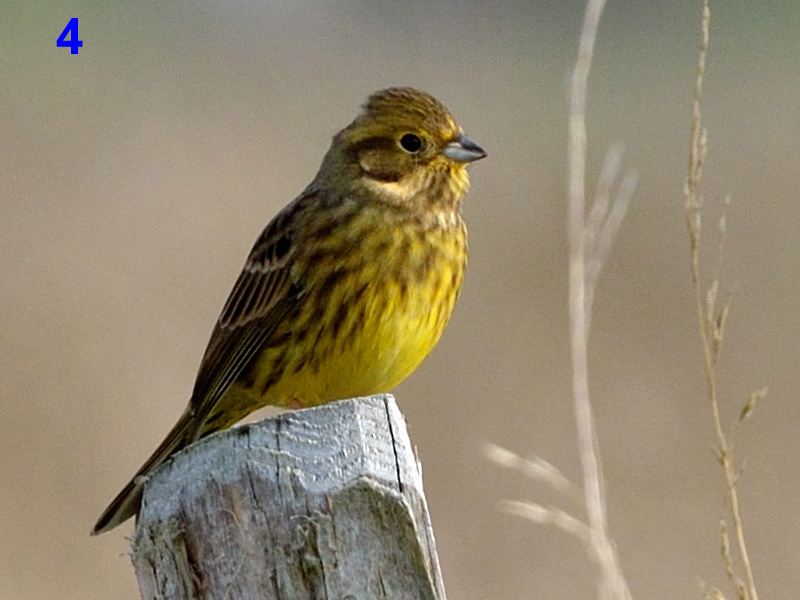
|
|
|
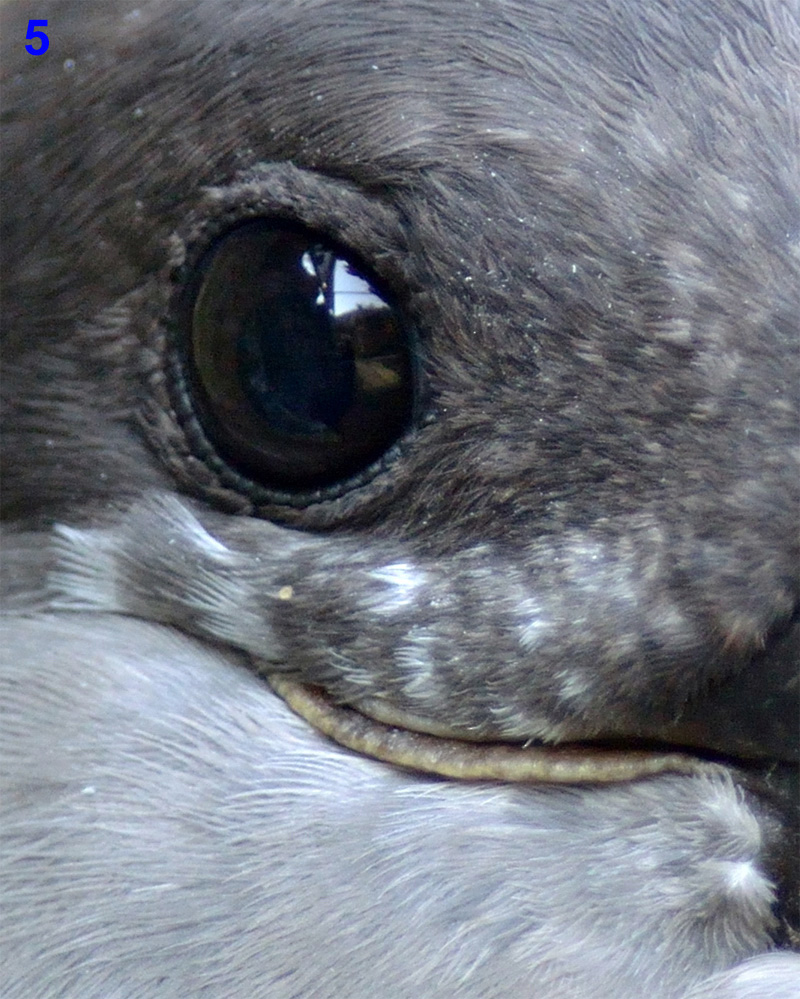
|
|
|

|
|
|
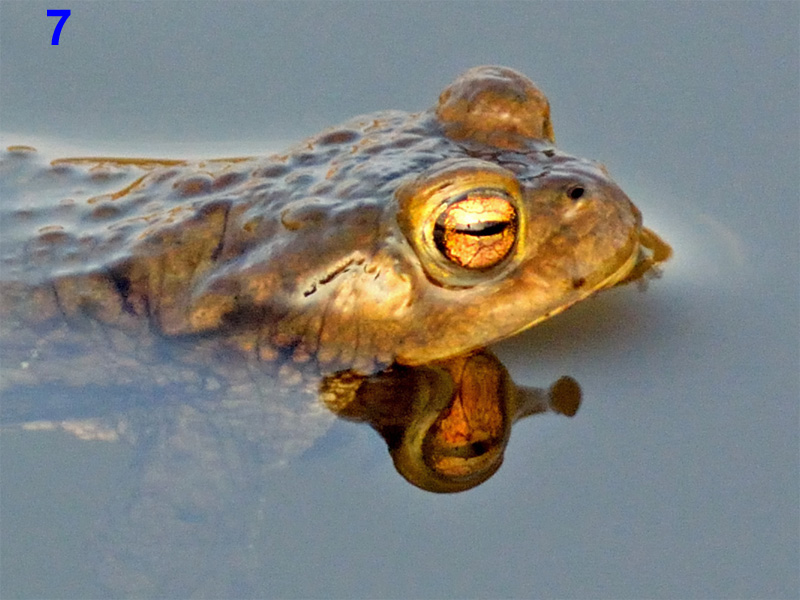
|
|
|
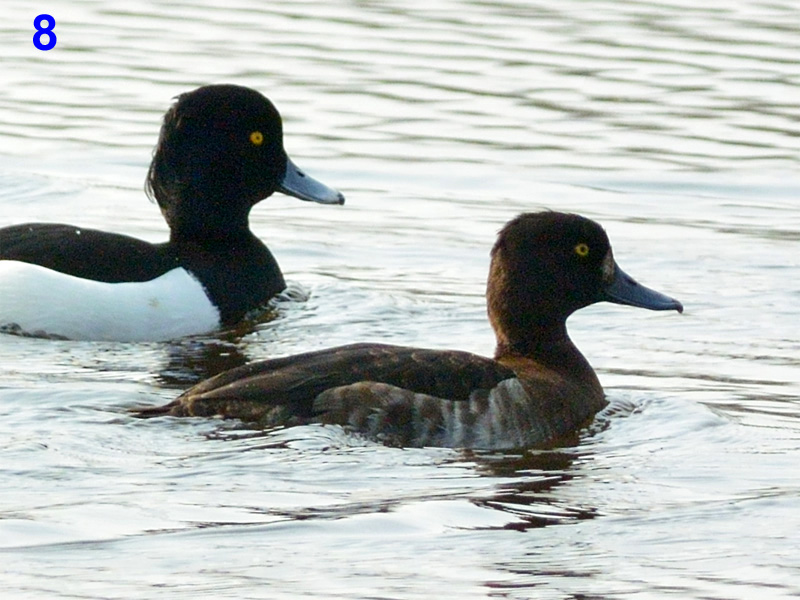
|
|
|
Solving: image 1, 4 and 6 have been captured with the D4.
Well, it is not a fair comparison. Three of the 1V2 images were shot on a monopod. The D4 images were shot hand-held under less light!
But what does it mean? How much additional reach do I get with the 1V2 combo over the D4 plus TC-14EIII plus AF-S 300mm f/4?
The lengthening factor is easy to compute: 810/420*75/100*sqrt(14/16) = 1.35.
In that formula "810" is the FX equivalent focal length of the 1V2 combination, "420" is the focal length of the TC-14EII plus 300mm lens, "75/100" is the downsizing factor for 1V2 images of 75% and "14" or "16" respectively are the MP counts of the two cameras.
In other words: the effective 35mm equivalent of the 1V2 combo is 420*1.35 = 568mm. Having in mind the weak AF system of the 1V2, it is not such a big deal. But if you have good light, a subject which moves not too fast and a monopod or better a tripod, you can achieve good results with the small camera.
An alternative could be a DX body with a better AF-System (D7100, D7200) in conjunction with the TC-14EII and the AF-S 300mm f/4. I have not tried it yet. But Nikon's DX bodies have a major problem which neither the D4 nor the 1V2 have: poor buffer capacity!